Up Next
In Her Photo-Based Tapestries, Detroit Artist Akea Brionne Conjures an Afro-Surrealist World
The artist's lens-based textiles are currently on view in “Trying to Remember” at Detroit’s Library Street Collective.
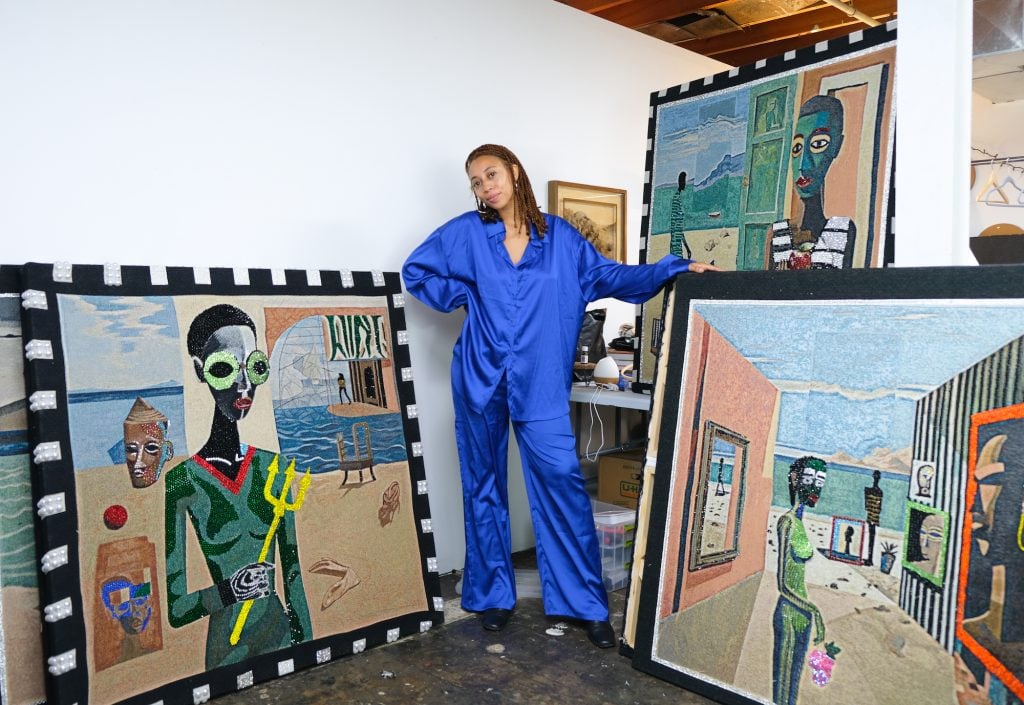
The artist's lens-based textiles are currently on view in “Trying to Remember” at Detroit’s Library Street Collective.

Katie White

Rising artist Akea Brionne is imagining an Afro-Surrealist world by the sea. In the 27-year-old artist’s mixed-media textile works, lone women, adorned with oversized sunglasses and cinched-waist dresses, stand with pharaonic poise against seascape backdrops while art historical elements such as African masks and De Chirico-esque architecture fill the spaces with uncanny strangeness.
“I’ve been thinking a lot about my relationship to the loss of knowledge and understanding oneself,” said Brionne during a recent video call. Her works—digitally printed jacquard tapestries that have been filled with doll stuffing and rags—are three-dimensional objects painstakingly adorned with beads. The works have a nearly votive effect. “A lot of this body of work is thinking about water as an elemental force that’s moved me to different places—I’ve moved from New Orleans to California to Maryland and Michigan, and Missouri in my life already. I think of these works as taking place in a dreamscape. Lately, I have been having these vivid dreams occurring by the ocean or where the desert and the ocean collide,” she explained.
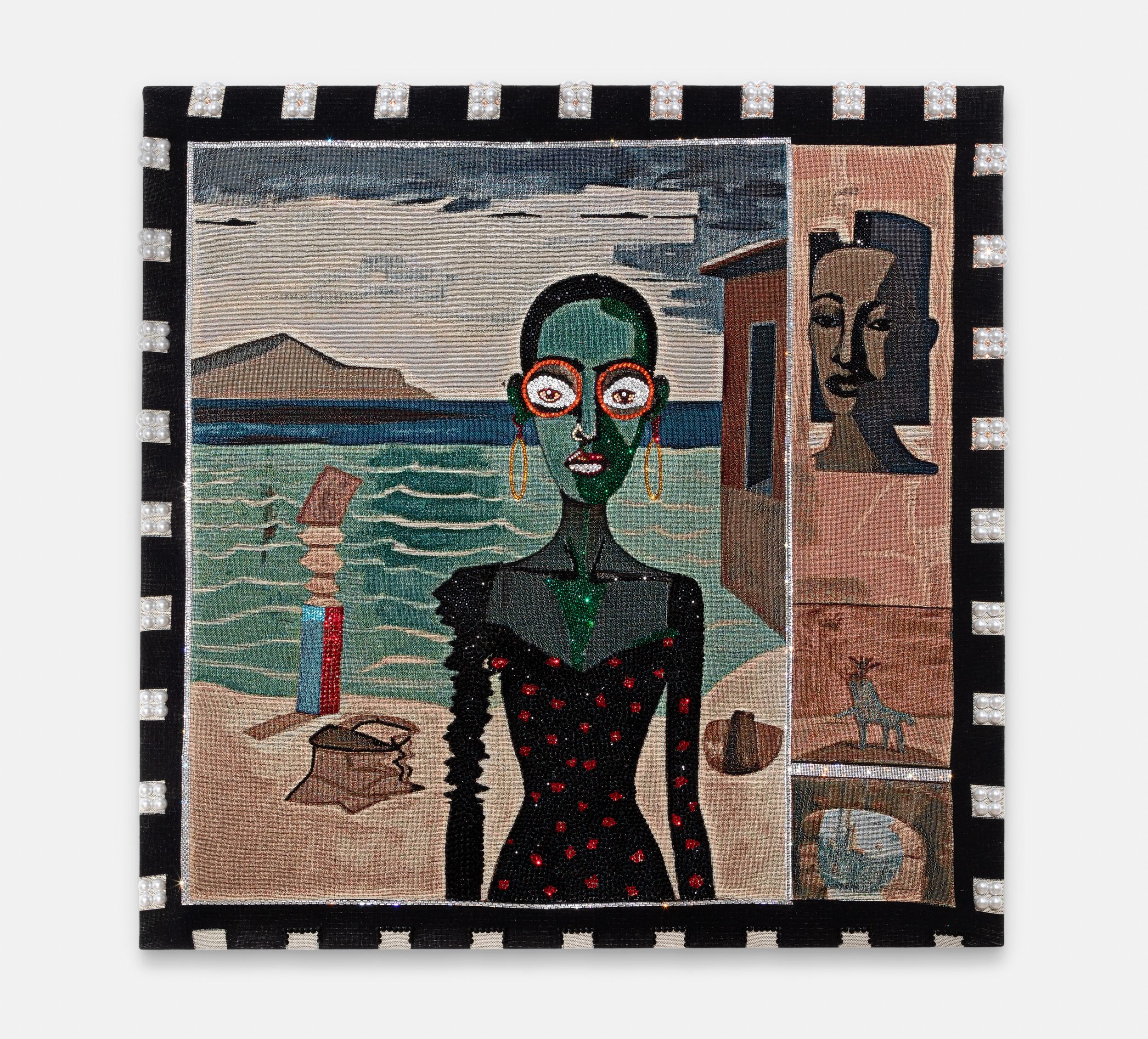
Akea Brionne, You’ll Find Me in the Sea (2023). Courtesy of the artist and Library Street Collective.
Right now, a dozen of these work are on view in the solo exhibition “Trying to Remember” at Detroit’s Library Street Collective (through January 6), a show that contemplates how colonialism has shaped and changed the storytelling, memory, and assimilation of the African diaspora both in the United States and the Caribbean—but specifically through Brionne’s familial experiences.
The exhibition is an important inflection point for the rapidly rising art world talent. This November, Forbes magazine named Brionne one of their ’30 Under 30′ in arts and culture. Her works have been exhibited by the Brooklyn Museum, the Mississippi Museum of Art, and the Baltimore Museum of Art in the past few years. This year, in Miami, Library Street Collective presented her works at Untitled Art Fair. In early 2024, Brionne will have her debut New York solo exhibition with Lyles & King as well as a presentation at Frieze LA 2024.
Amid this whirlwind of activity, Brionne—and her works—remain deeply rooted in landscapes and stories outside of the art world’s urban capitals. At their core, these works consider the artist’s familial migration from Belize and Honduras to New Orleans and the coast of Delaware—then outwards and across the U.S. as climate change has changed these landscapes. (Currently, Brionne splits her time between Detroit and Kansas City, Missouri, where she is an AICAD Fellow and assistant professor at the Kansas City Art Institute.)
“New Orleans is known as the northernmost Caribbean city. It’s a melting pot of French, African, Spanish, and Indigenous cultures. When Katrina happened in 2005, I was eight years old,” recalled Brionne. “Since then, my family’s been scattered across the South and the Southwest. The South is the landscape I identify with but it’s one that introduced us into this new wave of really extreme weather patterns. Seeing what my family has gone through and how much it’s shifted our relationship to this space—most of my family does not want to go back. It’s traumatizing. And it’s informed how I think about climate change and frontline communities of color, who live on coastlines and who are going to be the first to be impacted.”
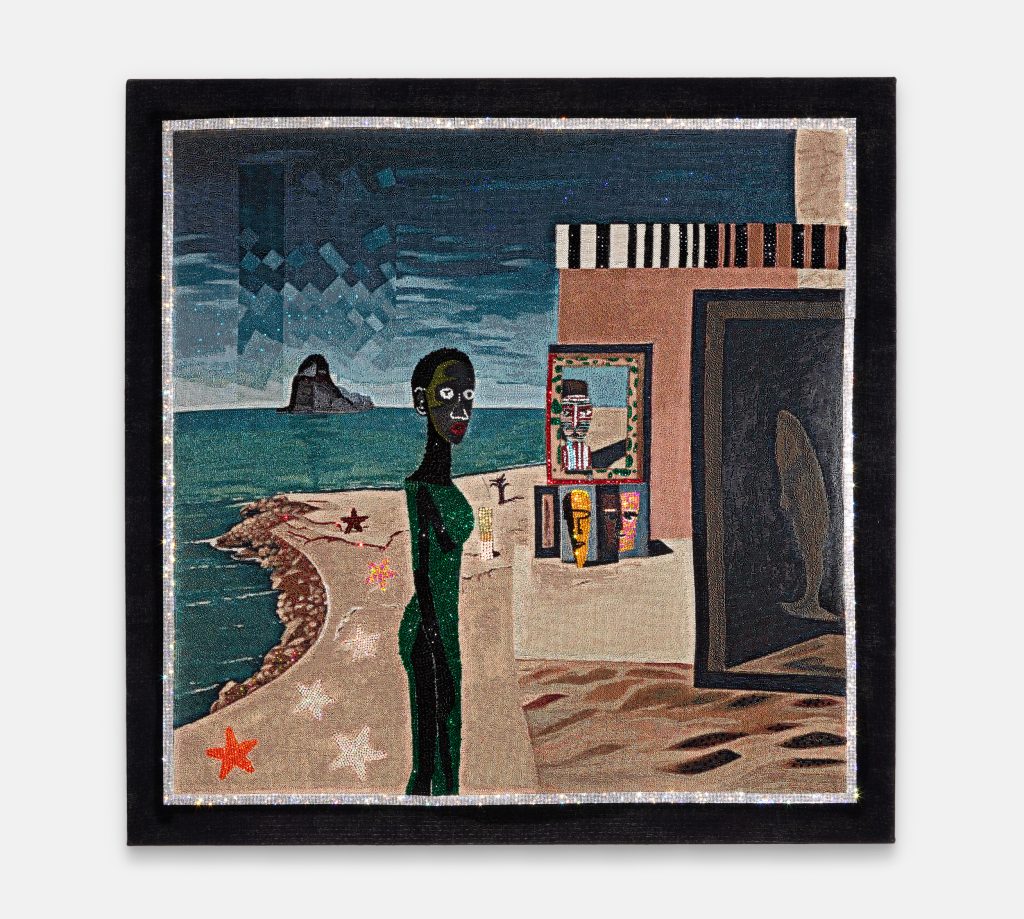
Akea Brionne, All Noir, You’re a Star (2023). Courtesy of the artist and Library Street Collective.
In her textiles, these concerns manifest outside of a real-world location—and seemingly harken to another world or dimension, one where the past and the future collide. These works are also Brionne’s acute investigations into medium. Brionne describes herself as a “lens-based textile artist.” What that means is that photography remains her first love; she studied photography as an undergraduate at the Maryland Institute College of Art and earned an MFA in photography from the Cranbrook Academy of Art in 2023. These textile works are, though unexpectedly, the result of an intensive process that begins with the artist taking photographic self-portraits.
“Photography and textile are colliding in this body of work,” said the artist. “I’m working from found imagery and imagery that I’ve taken, self-portraits, and other images. Then I’m using AI software and collaging the works together to create these landscapes that I’m seeing in my dreams,” she explained. Once she’s satisfied with her imagery, Brionne edits, adding other layers of distortions, and adjusting colors and formats. Then she sends the files off to be fabricated into jacquard tapestries. Once she receives the textiles from the manufacturer, she stuffs the works with doll stuffing and rags, often scraps from past works, to imbue the works with dimensionality. Then she sets to work spending long hours beading their surfaces.
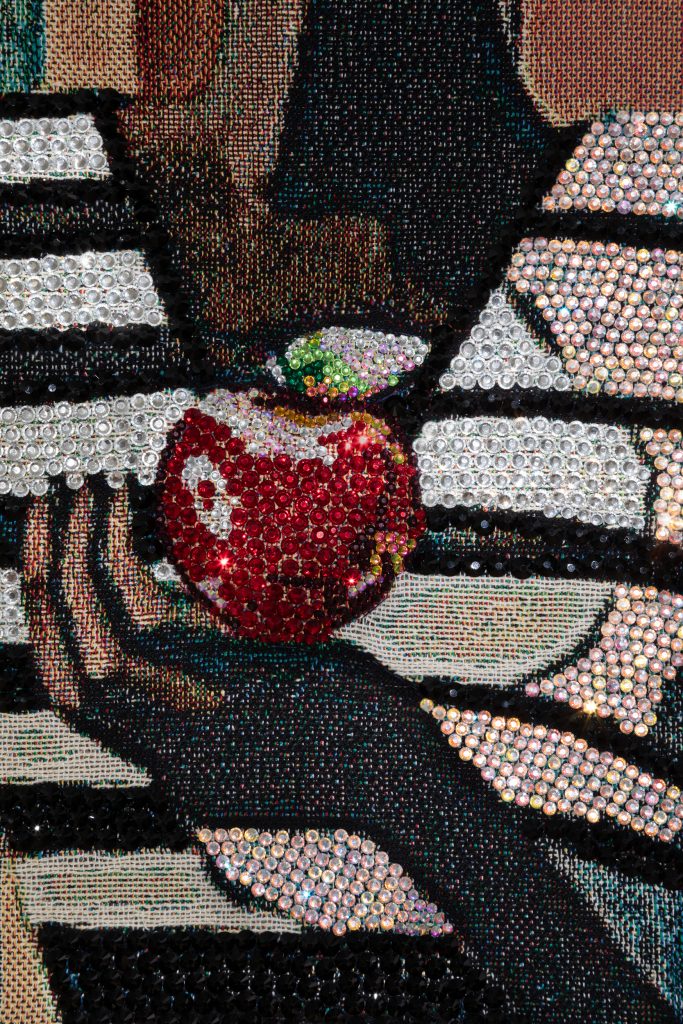
Detail of The Paradox of Eve (2023) by Akea Brionne. Courtesy of the artist and Library Street Collective.
“A lot of practice is centered around trying to make photography and image-making digestible and interesting again. Photography is the foundation of everything that I’m doing. A lot of people have called my works paintings as of late but these works are lens-based textiles. It’s my way of making photography more interesting and giving a way to engage with outside of just people thinking it’s a print that’s hanging on a wall,” she said.
The women in her works, based on her self-portraits, are another sly reference to the history of photography. “Because of the mechanics of the process, in early portraits people weren’t physically able to move. This is why people in early photographs appear so stoic, not very fluid in the body and very straight on,” she said. “Some people have asked why I don’t vary the compositions more, but I’m not trying to reference a history of painting. I’m trying to reference a history of photography.”
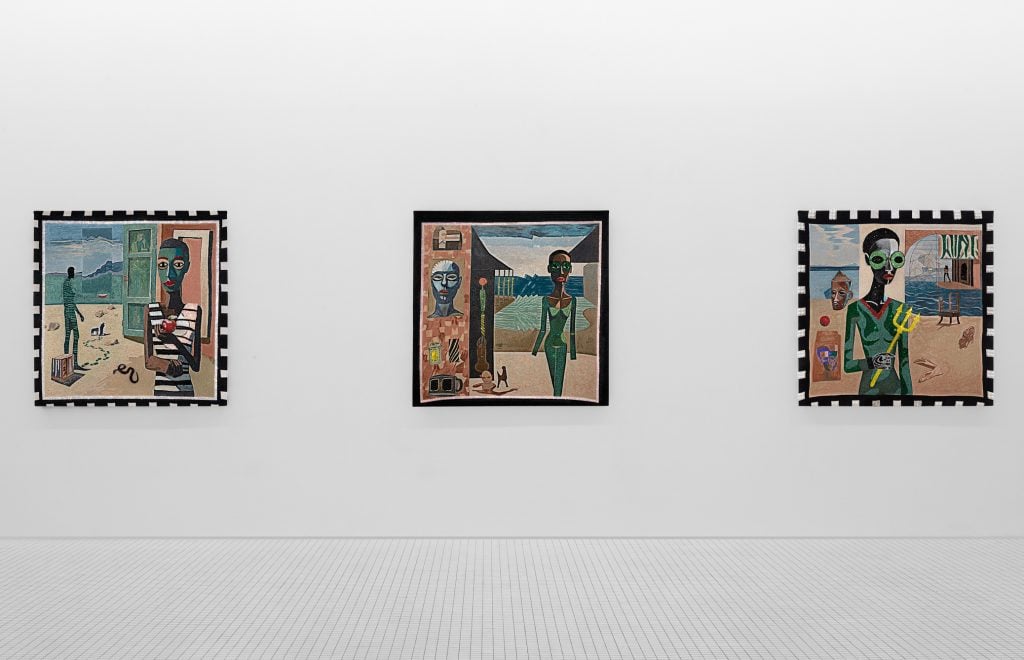
Installation views of Akea Brionne: Trying to Remember on view at Library Street Collective from November 17, 2023 – January 6, 2024. Photos by PD Rearick. Courtesy of the artist and Library Street Collective
But, intentionally or otherwise, these works do move beyond photographic history and into the worlds of folkloric, mythological, and biblical references. Cubism tendencies can be gleaned in the geometric and fragmented structures of her figures and scenes. Diego Rivera she acknowledges as an influence, along with American artist William H. Johnson and the history of African masks and sculpture.
In the work The Paradox of Eve (2023), a woman holds an apple, seductively layered in beads, a tempting reference to the story of Adam and Eve and their banishment from Eden. Raised in a Christian religious household, Brionne here grapples with her experiences rooted in a culture of fear, which isolated her from the longer legacies of her family’s history. Brionne recalls how the story of Eve shaped her understanding of womanhood as tied to sinfulness.
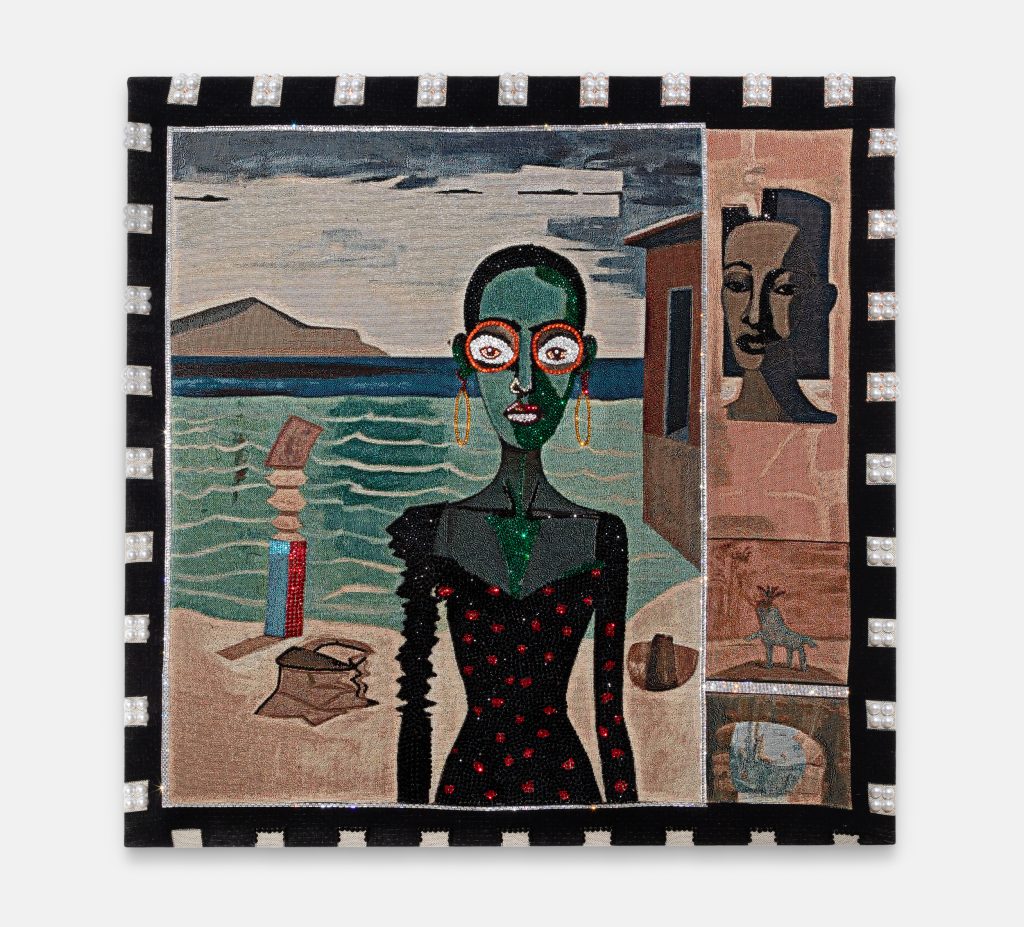
Akea Brionne, You’ll Find Me in the Sea (2023). Courtesy of the artist and Library Street Collective.
“Though my mom raised me in a strict Christianity, my mom was not raised religiously. This is another element that I’ve been contending with—my mom was going through something of her own and it manifested in me being indoctrinated in ideologies that she doesn’t even agree with,” she explained. These references become a time stamp on a much longer familial legacy the artist is communing with and her textile works offer dimension to connect with ancestors and a history that lives outside of the confines of time and space, religion and politics—even life and death.
“In a lot of my dreams I am talking to family members who have passed, or family members that I never got to meet, but with whom I feel like I have a spiritual relationship—these are experiences that are not in line with the Christian ideology I was raised with,” said the artist. “A lot of what’s happening in these works is me trying to figure out how much of my family’s history I can tap into and those practices and that spirituality from the here and now.”
More Trending Stories:
Art Dealers Christina and Emmanuel Di Donna on Their Special Holiday Rituals
Stefanie Heinze Paints Richly Ambiguous Worlds. Collectors Are Obsessed
Inspector Schachter Uncovers Allegations Regarding the Latest Art World Scandal—And It’s a Doozy
Archaeologists Call Foul on the Purported Discovery of a 27,000-Year-Old Pyramid
The Sprawling Legal Dispute Between Yves Bouvier and Dmitry Rybolovlev Is Finally Over
